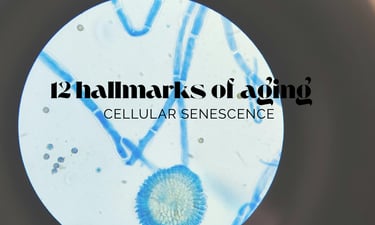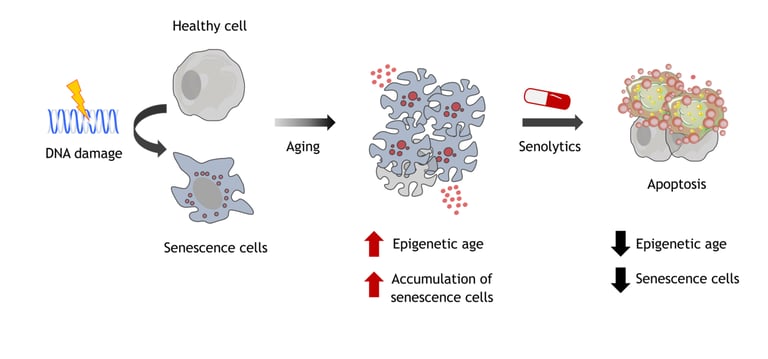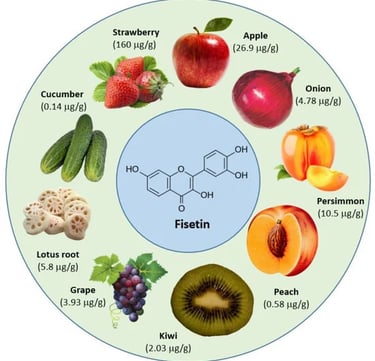The Zombie Cell Apocalypse: How to Clear Senescent Cells for Longevity
9/25/20257 min read


There's a concept in aging that sounds like it was pulled from a sci-fi script: inside your body, there are cells that refuse to die. They stop doing their jobs, resist the natural cycle of renewal, and linger like ghosts in your tissues. But these aren't benign spirits. They are "zombie cells," and they actively corrupt their healthy neighbors, spreading dysfunction and inflammation.
This isn't science fiction; it's the science of cellular senescence. The slow, creeping accumulation of these zombie cells is now understood to be a primary Hallmark of Aging, a key reason our bodies feel and look older over time (López-Otín et al., 2023).
The idea of a zombie apocalypse happening within your own tissues is unsettling, but here's the exciting part: science is finding ways to fight back. This article will explain what these zombie cells are, how they drive aging, and explore the cutting-edge field of senolytics (compounds that may give us a way to clear them out).
The Science: What are zombie cells?
To understand the problem, we have to appreciate that senescence started as a good thing. It's a powerful, natural defense mechanism. When a healthy cell suffers significant DNA damage or reaches its maximum number of divisions (a phenomenon known as the Hayflick limit), it wisely exits the cycle of replication to avoid becoming cancerous. It becomes senescent.
The problem isn't the existence of these cells. It's their accumulation. As we age, our immune system, which normally acts as a "zombie patrol" to identify and eliminate these cells, becomes less efficient. They begin to build up in our organs, joints, fat tissue, and skin.
The real danger lies in what these zombie cells do. They don't just sit there quietly, they secrete a toxic cocktail of inflammatory molecules known as the Senescence-Associated Secretory Phenotype (SASP). Think of the SASP as an inflammatory scream that damages surrounding healthy cells, degrades the structural integrity of tissues (like collagen in the skin), and fuels the low-grade, chronic inflammation that is itself another Hallmark of Aging.


Zombie cells are a natural part of life. It's only when our body's cleanup crews fall behind - and the zombies start to accumulate - that the real damage begins.
The Dashboard: Can You Measure Your Zombie Cell Load?
While there is no standard, direct-to-consumer blood test to measure your body's total senescent cell burden yet, researchers are making progress. For now, we can look at practical proxies:
Inflammatory Markers: Since the SASP is highly inflammatory, high levels of blood markers like hs-CRP can be an indirect clue that you may have a high senescent cell load.
Future Tech: In research, scientists can track specific biomarkers like p16INK4a to identify senescent cells. This work may one day lead to advanced diagnostic tests for the public.


The Action Plan: Your Evidence-Based Toolkit
While the science is new, evidence points toward several strategies that can help manage the senescent cell burden.
The Foundational Levers
Diet & Nutrition: Certain plant compounds have shown promise in helping the body manage senescent cells.
Quercetin: A powerful flavonoid found in foods like onions, apples, capers, and kale.
Fisetin: Another potent flavonoid found in high concentrations in strawberries, as well as in smaller amounts in apples and persimmons. (Note: Whenever possible, choosing organic, seasonal, and local produce will maximize the concentration of these beneficial compounds and minimize your exposure to pesticides.)
Exercise: Consistent physical activity is a double-win. It helps modulate the immune system, making your natural "zombie-clearing" patrols more effective at their job.
Fasting & Caloric Restriction: Activating autophagy (the body's cellular cleanup process) through fasting can help degrade the inflammatory SASP proteins that senescent cells release, effectively reducing their harmful downstream effects.
While senolytics offer targeted solutions, the first line of defense against zombie cells is an empowered immune system, fueled by smart choices in diet and exercise.
The Emerging Toolkit
The Foundational Supplements:
Vitamin D: As a crucial immune modulator, ensuring you have sufficient Vitamin D levels is essential for equipping your immune system to effectively identify and clear out senescent cells.
Omega-3 Fatty Acids: These are potent anti-inflammatory agents. They directly counteract the toxic, inflammatory SASP signals sent out by zombie cells, helping to protect healthy tissue from damage.
The Senolytic Compounds (The "New" Ones): "Senolytics" are a class of compounds that selectively trigger apoptosis (programmed cell death) in senescent cells while leaving healthy cells unharmed.
Dasatinib + Quercetin (D+Q): This combination of a chemotherapy drug and the plant flavonoid quercetin is the most-studied senolytic cocktail in humans. Pioneering trials from the Mayo Clinic have shown it can clear senescent cells and improve physical function in people with specific age-related diseases (Hickson et al., 2019).
Fisetin: This natural flavonoid has demonstrated powerful senolytic effects in animal studies, leading to extended healthspan and lifespan in mice (Yousefzadeh et al., 2018).
Hype vs. Reality: It is crucial to state that senolytic therapy is still experimental. While incredibly promising, the long-term safety and effectiveness for general anti-aging in healthy humans are not yet established.






The Network Effect: How Zombie Cells Create Chaos
The accumulation of senescent cells has devastating ripple effects across the other Hallmarks of Aging:
The Inflammation Link: This is the most direct connection. The SASP is a primary engine of chronic inflammation (inflammaging).
The Genomic Instability Link: Cells often become senescent because of severe genomic instability, acting as a last-ditch effort to prevent cancer.
The Stem Cell Link: The toxic SASP creates a hostile environment for stem cells, impairing their ability to repair tissues and directly contributing to stem cell exhaustion.
The Horizon: The Next Generation of Senolytics
This is one of the fastest-moving fields in longevity science. Researchers are actively developing "second-generation" senolytics that are more targeted with fewer side effects. They are also optimizing dosing schedules, as studies suggest a "hit-and-run" approach, dosing intermittently every few weeks or months, may be all that's needed to keep the zombie population under control.
Key Takeaways:
Cellular senescence is a state where damaged cells stop dividing but resist death, accumulating in tissues as we age.
These "zombie cells" secrete a harmful cocktail of inflammatory molecules (the SASP) that drives inflammation and damages healthy cells.
Lifestyle factors like diet (rich in quercetin and fisetin), exercise, and fasting can help your body manage this burden.
Foundational supplements like Vitamin D and Omega-3s support the body's natural defenses against the effects of senescence.
A new class of compounds called senolytics, which can selectively clear these cells, is one of the most promising frontiers in longevity research.
The Road Ahead
We are now unwrapping each Hallmark in great detail, exploring what it is, how to measure it, and how to improve it. Once we have the foundations in place, I cannot wait to share which supplement brands I have tried and what I like about them. But first, let’s build the knowledge so that your decisions can be better informed by the one person who knows your body best: you.
Clearing out these lingering 'zombie' threats is a powerful step, but true longevity demands addressing all the Hallmarks - a holistic approach to health.
Important Terms
Cellular Senescence - The process by which a cell ages and permanently stops dividing but does not die.
SASP (Senescence-Associated Secretory Phenotype) - A cocktail of inflammatory proteins, growth factors, and enzymes that senescent cells release, which can damage surrounding tissues.
Senolytics - A class of drugs or natural compounds that can selectively induce death (apoptosis) in senescent cells.
Quercetin & Fisetin - Naturally occurring plant compounds (flavonoids) that have been shown to have senolytic properties.
Apoptosis - The natural, orderly process of programmed cell death, which the body uses to remove old or damaged cells.


References
Di Micco, R., Krizhanovsky, V., Baker, D., & d'Adda di Fagagna, F. (2021). Cellular senescence in ageing: From mechanisms to therapeutic opportunities. Nature Reviews Molecular Cell Biology, 22(2), 75–95. https://doi.org/10.1038/s41580-020-00314-w
Hickson, L. J., Langhi Prata, L. G. P., Bobart, S. A., Evans, T. K., Giorgadze, N., Hashmi, S. K., Herrmann, S. M., Jensen, M. D., Jia, Q., Jordan, K. L., Kellogg, T. A., Khosla, S., Koerber, D. M., Lagnado, A. B., Lawson, D. K., LeBrasseur, N. K., Lerman, L. O., McDonald, K. M., McKenzie, T. J., ... Kirkland, J. L. (2019). Senolytics decrease senescent cells in humans: Preliminary report from a clinical trial of Dasatinib plus Quercetin in individuals with diabetic kidney disease. EBioMedicine, 47, 446–456. https://doi.org/10.1016/j.ebiom.2019.08.069
Kirkland, J. L., & Tchkonia, T. (2020). Senolytic drugs: From discovery to translation. Journal of Internal Medicine, 288(5), 518–536. https://doi.org/10.1111/joim.13141
López-Otín, C., Blasco, M. A., Partridge, L., Serrano, M., & Kroemer, G. (2013). The hallmarks of aging. Cell, 153(6), 1194–1217. https://doi.org/10.1016/j.cell.2013.05.039
López-Otín, C., Kroemer, G., Partridge, L., Serrano, M., & Blasco, M. A. (2023). Hallmarks of aging: An expanding universe. Cell, 186(2), 243–278. https://doi.org/10.1016/j.cell.2022.11.001
Yousefzadeh, M. J., Zhu, Y., McGowan, S. J., Angelini, L., Fuhrmann-Stroissnigg, H., Xu, M., Ling, Y. Y., Melos, K. I., Pirtskhalava, T., Inman, C. L., McGuckian, C., Wade, E. A., Kato, J. I., Grassi, D., Wentworth, M., Burd, C. E., Arriaga, E. A., Ladiges, W. L., Tchkonia, T., ... Niedernhofer, L. J. (2018). Fisetin is a senotherapeutic that extends health and lifespan. EBioMedicine, 36, 18–28.https://doi.org/10.1016/j.ebiom.2018.09.015
Explore
Discover insights on longevity and wellness.
lONGEVITY EXPLAINED
© 2025. All rights reserved.
Terms and conditions
